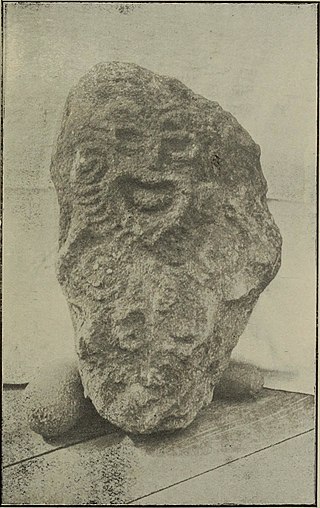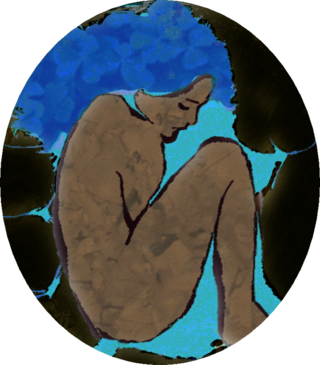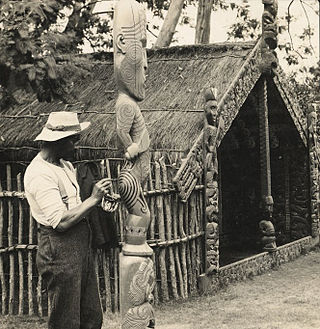This article needs additional citations for verification .(September 2019) |

Avaiki is one of the many names by which the peoples of Polynesia refer to their ancestral and spiritual homelands.
This article needs additional citations for verification .(September 2019) |

Avaiki is one of the many names by which the peoples of Polynesia refer to their ancestral and spiritual homelands.
By no means certain, but certainly possible, is an origin in the large islands of Samoa, namely Savaii and Upolu. Variants include, in order of migration, Havaii, the old name for Raiatea in French Polynesia; the far better known Hawaii in the United States, Avaiki in the Cook Islands and Niue and Hawaiki in New Zealand.
There are endless local variants. In the Cook Islands, for example, on the capital island of Rarotonga, northern facing volcanic rocks, tumbling onto the shore millennia ago and still set in place, are well known as the ancient departure point for souls bound for Avaiki - the afterworld or heaven.
In fact each island, vaka or ngati (family line) has its own Avaiki or interpretation of it. For instance it would be somewhere in the Manu'a islands group (American Samoa) for the Ngati Karika (Te au o Tonga tribe - Rarotonga). [1] For the Ngati Tangi'ia (Takitumu tribe-Rarotonga), it would be at Tahiti. Others locate Avaiki at Raiatea...
In the mythology of Mangaia in the Cook Islands, Avaiki is the "underworld" or "netherworld". It is described like a hollow of a vast coconut shell. Varima-te-takere, the mother of Vatea, lives in the lowest depths of the interior of this coconut shell. [2] : 392 Nevertheless, the New Zealand anthropologist Peter Buck (Te Rangi Hīroa), gives a less mystical interpretation of this Mangaian Avaiki: "when Tangi'ia came to Rarotonga from Tahiti, he brought with him some rankless "manahune" [commoners] ... As they had no chance of rising in social status, some of them under the leadership of Rangi migrated to Mangaia to start a new life (c.1450–1475). Their antagonism toward Rarotonga made them conceal the land of origin and invent an origin from a spiritual homeland in the netherworld of Avaiki." [3]
While Solomon Islands is mostly considered Melanesia, the province of Rennell and Bellona is Polynesian. The province consists of Rennell Island, Bellona Island and the uninhabited Indispensable Reefs.
The locals call Rennell Island “MUNGAVA” and they call Bellona Island “MUNGIKI”. They then combine the last three letters of each Island and come up with a word called AVAIKI. If someone local does something silly you might hear someone say ‘That’s the Avaiki way’. A further example of this nomenclature can also be evidenced with the identification of the name of the Province, Renbel which combines Rennell and Bellona. MV Renbel is also the name of the ferry that supplies the province from Honiara.
There is also a rugby and netball team on Rennell Island called Avaiki.

Polynesian mythology encompasses the oral traditions of the people of Polynesia together with those of the scattered cultures known as the Polynesian outliers. Polynesians speak languages that descend from a language reconstructed as Proto-Polynesian – probably spoken in the Tonga and Samoa area around 1000 BC.

In Māori mythology, Rongo or Rongo-mā-Tāne is a major god (atua) of cultivated plants, especially kumara, a vital crop. Other crops cultivated by Māori in traditional times included taro, yams (uwhi), cordyline (tī), and gourds (hue). Because of their tropical origin, most of these crops were difficult to grow except in the far north of the North Island, hence the importance of Rongo in New Zealand.
Tangaroa is the great atua of the sea, lakes, rivers, and creatures that live within them, especially fish, in Māori mythology. As Tangaroa-whakamau-tai he exercises control over the tides. He is sometimes depicted as a whale.
In Polynesian languages the word aitu refers to ghosts or spirits, often malevolent. The word is common to many languages of Western and Eastern Polynesia. In the mythology of Tonga, for example, ʻaitu or ʻeitu are lesser gods, many being patrons of specific villages and families. They often take the form of plants or animals, and are often more cruel than other gods. These trouble-making gods are regarded as having come from Samoa. The Tongan word tangi lauʻaitu means to cry from grief, to lament.

In Cook Islands mythology, Avatea was a lunar deity and the father of gods and men in Mangaian myth of origin. His eyes were thought to be the Sun and the Moon; he was also known as the god of light.
In Polynesian mythology, Hawaiki is the original home of the Polynesians, before dispersal across Polynesia. It also features as the underworld in many Māori stories.

A marae, malaʻe, meʻae or malae is a communal or sacred place that serves religious and social purposes in Polynesian societies. In all these languages, the term also means cleared and free of weeds or trees. Marae generally consist of an area of cleared land roughly rectangular, bordered with stones or wooden posts perhaps with paepae (terraces) which were traditionally used for ceremonial purposes; and in some cases, a central stone ahu or a'u. In the Rapa Nui culture of Easter Island, the term ahu has become a synonym for the whole marae complex.

Raiatea or Ra'iatea is the second largest of the Society Islands, after Tahiti, in French Polynesia. The island is widely regarded as the "centre" of the eastern islands in ancient Polynesia and it is likely that the organised migrations to the Hawaiian Islands, New Zealand and other parts of East Polynesia started at Raiatea.

Mangaia is the most southerly of the Cook Islands and the second largest, after Rarotonga. It is a roughly circular island, with an area of 51.8 square kilometres (20.0 sq mi), 203 kilometres (126 mi) from Rarotonga. Originally heavily populated, Mangaia's population has dropped by 75% in the last 50 years.
Cook Islands Māori is an Eastern Polynesian language that is the official language of the Cook Islands. Cook Islands Māori is closely related to New Zealand Māori, but is a distinct language in its own right. Cook Islands Māori is simply called Māori when there is no need to disambiguate it from New Zealand Māori, but it is also known as Māori Kūki ʻĀirani or controversially Rarotongan. Many Cook Islanders also call it Te reo Ipukarea, literally "the language of the Ancestral Homeland".

Rennell Island, locally known as Mugaba, is the main island of two inhabited islands that make up the Rennell and Bellona Province in the nation state of Solomon Islands. Rennell Island has a land area of 660 square kilometres (250 sq mi) that is about 80 kilometres (50 mi) long and 14 kilometres (8.7 mi) wide. It is the second largest raised coral atoll in the world with the largest lake in the insular Pacific, Lake Tegano, a lake that is listed as a World Heritage Site. Rennell Island has a population of about 1,840 persons of Polynesian descent who primarily speak Rennellese, Pijin and some English. Rennell and Bellona Islands are two of the few islands in the otherwise Melanesian Solomon Islands archipelago classified as a Polynesian outlier; others being Sikaiana, Ontong Java, Tikopia, Anuta, Duff Islands, and some Reef Islands.

In Cook Islands mythology, Varima-te-takere also called Vari, was the primordial mother of the gods and mortals.

In Māori mythology, Tiki is the first man created by either Tūmatauenga or Tāne. He found the first woman, Marikoriko, in a pond; she seduced him and he became the father of Hine-kau-ataata. By extension, a tiki is a large or small wooden, pounamu or stone carving in humanoid form, notably worn on the neck as a hei-tiki, although this is a somewhat archaic usage in the Māori language. Hei-tiki are often considered taonga, especially if they are older and have been passed down throughout multiple generations. Carvings similar to ngā tiki and coming to represent deified ancestors are found in most Polynesian cultures. They often serve to mark the boundaries of sacred or significant sites. In the Western world, Tiki culture, a movement inspired by various Pacific cultures, has become popular in the 20th and 21st centuries; this has proven controversial, however, as the movement is regarded by many Polynesians as cultural appropriation.
Rakahanga-Manihiki is a Cook Islands Maori dialectal variant belonging to the Polynesian language family, spoken by about 2500 people on Rakahanga and Manihiki Islands and another 2500 in other countries, mostly New Zealand and Australia. Wurm and Hattori consider Rakahanga-Manihiki as a distinct language with "limited intelligibility with Rarotongan". According to the New Zealand Maori anthropologist Te Rangi Hīroa who spent a few days on Rakahanga in the years 1920, "the language is a pleasing dialect and has closer affinities with [New Zealand] Maori than with the dialects of Tongareva, Tahiti, and the Cook Islands"
Akava'ine is a Cook Islands Māori word which has come, since the 2000s, to refer to transgender people of Māori descent from the Cook Islands.
Wood carving is a common art form in the Cook Islands. Sculpture in stone is much rarer although there are some excellent carvings in basalt by Mike Tavioni. The proximity of islands in the southern group helped produce a homogeneous style of carving but which had special developments in each island. Rarotonga is known for its fisherman's gods and staff-gods, Atiu for its wooden seats, Mitiaro, Mauke and Atiu for mace and slab gods and Mangaia for its ceremonial adzes. Most of the original wood carvings were either spirited away by early European collectors or were burned in large numbers by missionary zealots.
Dorice Reid, also known by the chiefly title Te Tika Mataiapo Dorice Reid, was a Cook Islander tourism official, businesswoman and judge. Reid enjoyed a long career in Cook Island business, politics and tourism from the 1970s until her death in 2011.

Cook Islands mythology comprises historical myths, legends, and folklore passed down by the ancient Cook Islanders over many generations. Many of the Cook Islands legends were recited through ancient songs and chants. The Cook Islands myths and legends have similarities to general Polynesian mythology, which developed over the centuries into its own unique character.

Marumaru Atua is a reconstruction of a vaka moana, a double-hulled Polynesian voyaging canoe. It was built in 2009 by the Okeanos Foundation for the Sea. In 2014, it was gifted to the Cook Islands Voyaging Society. It is used to teach polynesian navigation.

Papeiha was an evangelist of the London Missionary Society. Trained by John Williams, he converted the islands of Aitutaki and Rarotonga in the Cook Islands to Christianity.